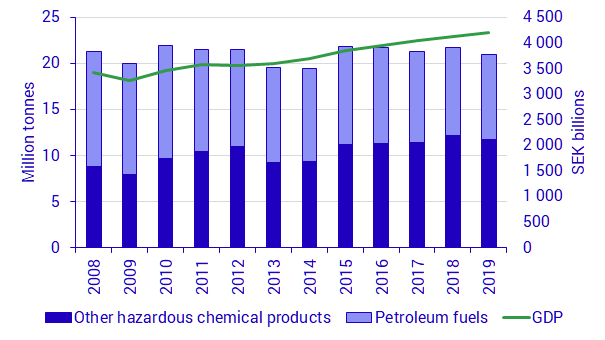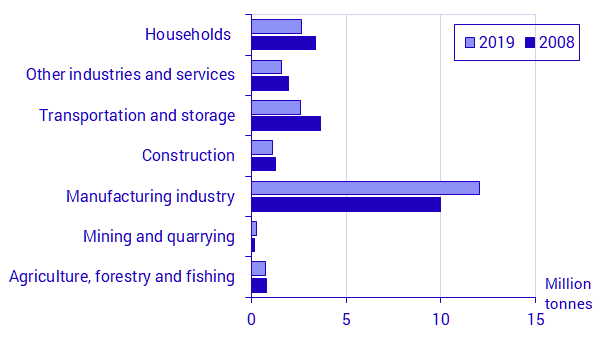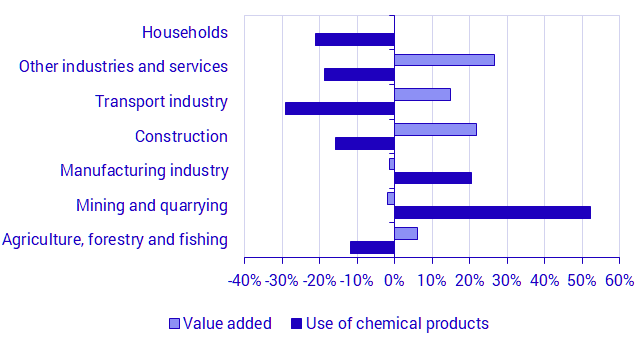Environmental accounts – Chemical indicators 2019
Use of chemical products decreased between 2018 and 2019
Statistical news from Statistics Sweden 2021-06-03 9.30
The use of chemical products classified as hazardous to health and the environment, including petroleum fuels, decreased by 3 percent between 2018 and 2019. Between 2008 and 2019, the use of chemical products decreased by 1 percent, mainly in the transport sector and in households.
In 2019, use of chemicals classified as hazardous to health and the environment, including petroleum fuels, amounted to 21 million tonnes. This is a decrease of 0.3 million tonnes from 2008. The use of petroleum fuels decreased by 3.2 million tonnes, while chemicals classified as hazardous to health and the environment increased by 2.9 million tonnes. During the same period, the use of chemical products in the manufacturing industry increased by 20 percent, which corresponds 2 million tonnes. In the same period, GDP increased by 23 percent. This means that chemical intensity, that is, the number of tonnes of chemicals per produced Swedish krona, decreased over this period. It is important to note that changes over time do not necessarily reflect real volume changes. For example, which chemicals are classified as hazardous to health and the environment may have changed.

Source: Statistics Sweden and the Swedish Chemicals Agency. Note: Petroleum fuel is hazardous to both health and the environment, but is shown here as a separate group.
The manufacturing industry is the industry that uses the most chemicals, 12 million tonnes, and also reported the largest increase since 2008, 2 million tonnes, in absolute terms. The transport industry and other industries and services also account for a large share of chemicals use.

Source: Statistics Sweden and the Swedish Chemical Agency
However, the largest increase in the period, 52 percent, is in the mining and quarrying industry. At the same time, value added in this industry decreased by 2 percent and there is a similar trend in the manufacturing industry. It is important to note that the mining and quarrying industry is much smaller than the manufacturing industry, both in terms of the use of chemicals (0.26 million tonnes and 12 million tonnes respectively) and their contribution to GDP (SEK 19.4 billion and SEK 522 billion respectively). Among the remaining industries, chemicals use has decreased and value added has increased.

Source: Statistics Sweden, Environmental accounts and national accounts, and the Swedish Chemicals Agency.
Revisions
Since the publication in May 2020, several revisions have been carried out.
The use of petroleum fuels by households is now included in the chemical indicators. The background to this is that households are counted as part of the economy according to framework delimitations within the environmental accounts.
Minor corrections were made regarding chemicals that are hazardous to health and the environment in documentation from the Swedish Chemicals Agency.
Definitions and explanations
The Swedish Chemicals Agency supervises the Products Register, in which chemical products are registered and for which there is a time series available from 1992. The primary purpose of the register is to enable supervision of import and manufacturing companies, to monitor national policy and for use by local authorities. The register contains information on which chemicals are used and the quantities.
The indicators published by Statistics Sweden measure the quantities of products classified as hazardous to health and environmentally hazardous according to international criteria. The standard classification of industries is also used (NACE).
Classification is based on Council Directive 67/548/EEC of 27 June 1967 on the approximation of laws, regulations and administrative provisions relating to the classification, packaging and labelling of dangerous substances. The Directive has been amended several times. The most recent version, with most changes introduced, is Regulation (EC) No 1272/2008 of the European Parliament and of the Council of 16 December 2008, which introduced a new classification, the Globally Harmonised System of Classification and Labelling of Chemicals (GHS). From 2015, reporting is only done in accordance with the GHS.
In these statistics, chemical products dangerous to health are classified as Very toxic (T+), Toxic (T), Corrosive (C), Irritant (Xi), and Harmful (Xn) according to KIFS 2005:7, and from 2009 onwards also in accordance with Regulation (EC) No 1272/2008 of the European Parliament and of the Council, concerning products classified as Corrosive (GHS05), Toxic (GHS06), Harmful (GHS07), Health hazard (GHS08), and Environmental hazard (GHS09).
Next publishing will be
The next statistical news in this series is scheduled for publishing in 2022.
Statistical Database
More information is available in the Statistical Database
Feel free to use the facts from this statistical news but remember to state Source: Statistics Sweden.
